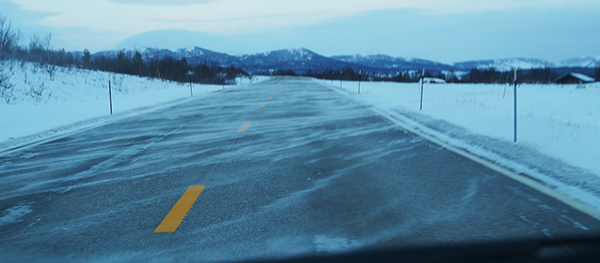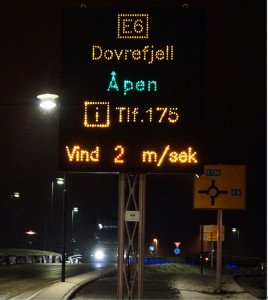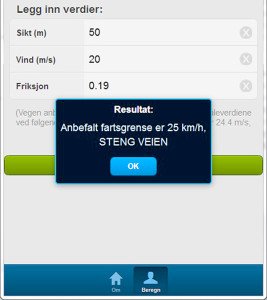In 2006 there was a bus accident on a mountain pass in Norway called Dovrefjell. There was strong wind combined with ice covered road. As a result of this very strong crosswind and the slippery conditions the bus lost the grip on the front wheels and the driver couldn’t control the bus. The bus went into the ditch, turned over and landed on its right side when reaching the flat ground. This type of accident is not rare in the mountain passes, and The Accident Investigation Board Norway (AIBN), that investigated the incident, has several recommendations which could improve the traffic safety on mountain passes like this. The Norwegian Public Roads Administration and the maintenance contractor Mesta are now working on a project trying to find criteria for when it is safe to drive over this pass.
One of the recommendations from AIBN was a better information system for the road users. If the bus driver had information about wind- and road conditions he would have had better possibility for right decision-making for safely crossing the mountain. Today there are three weather stations up on the mountain that are connected to variable signposts located in two small villages (Dombaas and Oppdal) on both sides of the mountain pass. The signposts give road users information about the strength of the wind on the mountain and also information if the mountain pass is open, closed or if convoy driving is introduced. In the winter season 2012/2013 a new service was launched with a SMS-warning informing the road users about the driving conditions on this specific section. There are also three web cameras available to the public.
The highway E6 crossing Dovrefjell was neither salted nor gritted before the aforementioned accident happened. During a storm, and especially when the wind is strong, it is difficult to spread sand or salt on the road. The grains of sand or salt will go with the wind before they reach the road surface. One solution is to use a mixture of very hot water and sand. The mixture of hot water and sand will stick to the ice and create very good friction if the temperature in the ground is below zero. If the weather is cold and stable this method can increase friction for several days, and action can be done before the storm starts.
Closings of mountain passes in Norway are normally related to snowstorms, danger for cars to get stuck in the snow, and to the visibility conditions. The weather condition the day the accident happened, with strong side wind and slippery road, are not a part of the factors considering for closing a road. Another recommendation from AIBN is clearer directives regarding management and closing of roads when such conditions appear.
The project has developed an application for mobile phones where input data are visibility, wind strength and friction. Input data can be retrieved from the three weather stations in this section of the road. The weather stations give data about the temperature, wind, air humidity and precipitation. On two of these stations there are also road surface state sensors which give us a friction index based on registration of the road condition in a small area of the road. Three cameras are installed in the mountain pass together with “home-made” signposts. The operators can consider the visibility for the road-users from their office, based on how many signposts that are visible in the camera view. Data from the weather station and the camera are input for the mobile phone application. The operator gives a certain visibility in meters, a friction coefficient and number for the wind gusts in m/s. Based upon the input data, the application gives a recommendation if the road should be open, if convoy driving should be introduced, or if the road should be closed.
Today the contractor and the client decide if the road should be open or not. In the future it may be possible to have an automatic closing of the road based on data from the weather station. There are gates on both side of the mountain which today is controlled by the contractor and road transport informatics.
 Contact: Contact:Bård Nonstad bard.nonstad@vegvesen.no NPRA, Norway |









Follow us: